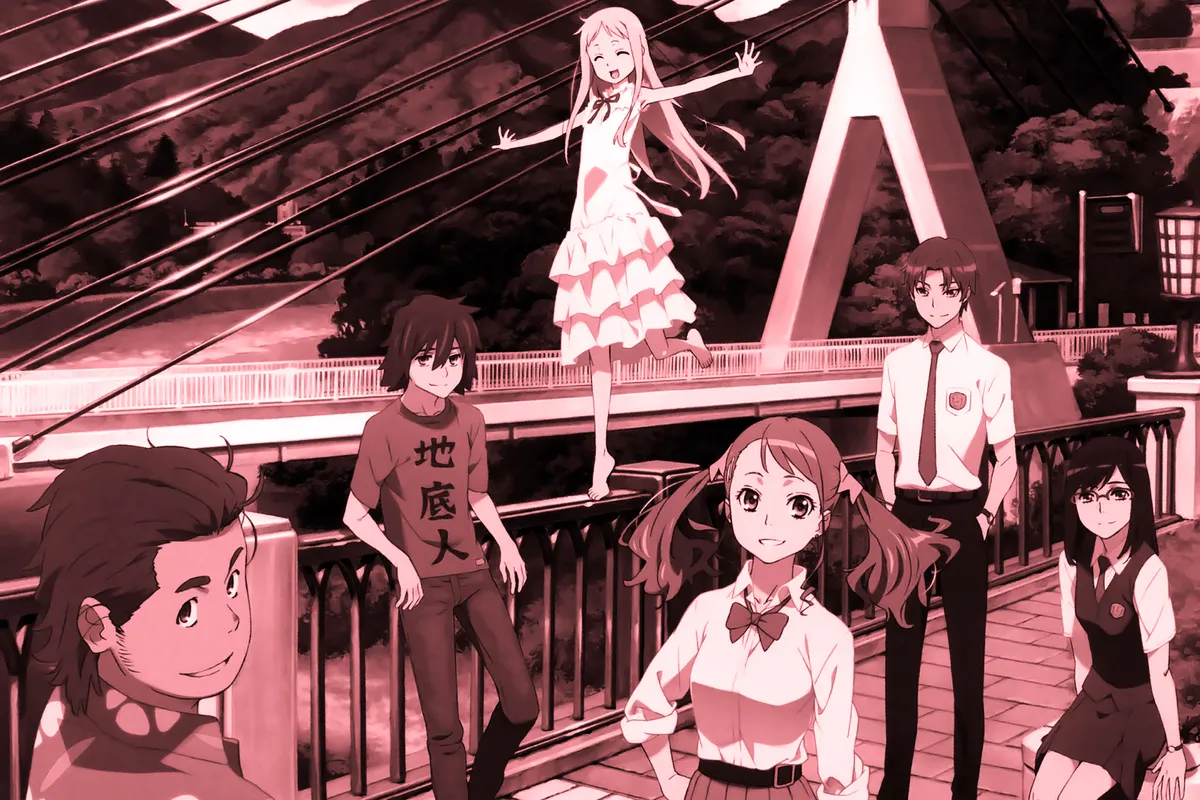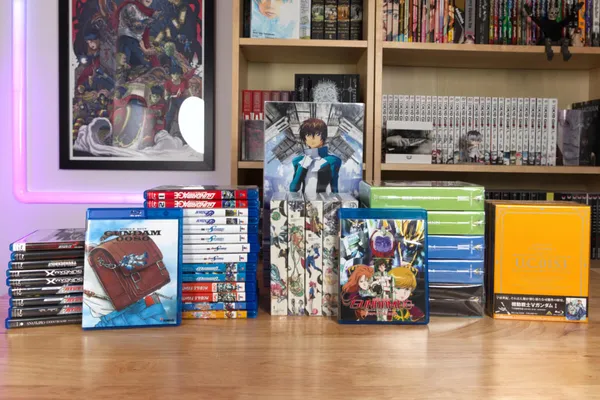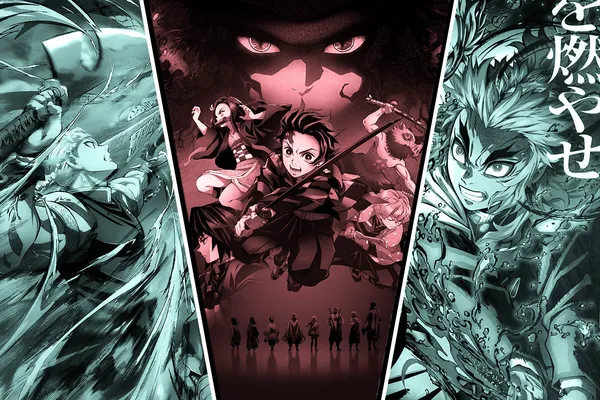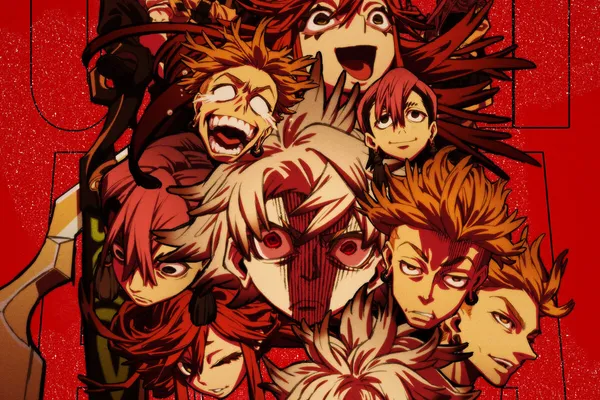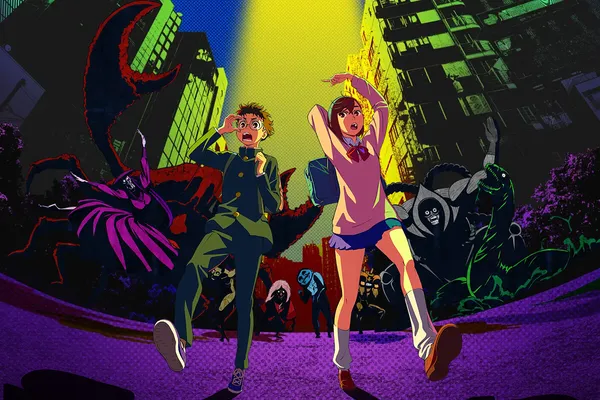Anohana: The Flower We Saw That Day is a slice-of-life drama anime with supernatural themes that was released in 2011. A-1 Pictures (Your Lie in April, Kaguya-sama: Love is War) animated the series. With only 11 episodes, it’s a relatively quick watch. A movie for Anohana was released too that you will want to check out after watching the anime because it is a direct sequel to the original series. Due to the success of its anime release, Anohana also received a live-action adaptation as well as a visual novel developed by 5pb (Steins;Gate), which was released on the PSP.
If you enjoy the anime and are looking to dive more into the character’s individual stories, the visual novel is a nice addition. While the source material, which is the anime, is the best way to experience Anohana, you get some more context in the visual novel that makes it worth checking out, especially if you have a PSP.
Anohana: The Flower We Saw That Day received a Blu-ray release in the form of a Complete Box Set that was released by Aniplex of America that you may want to check out as well. I own it and it is a beautiful, high-quality release, so I highly recommend it, especially if you enjoy owning your series physically. If not, it’s easy to find digitally and it’s one of the best anime streaming on Crunchyroll right now.
That said, before I get into my review of Anohana and what makes it such an amazing anime, I want to first talk about what it’s about for those of you who are completely new to the series.
What is Anohana: The Flower We Saw That Day about?
Our main character Jinta Yadomi and his childhood friends are fragmented after the loss of their friend, Menma, when they were young. But, in their high school years, a surprising event reunites Jinta and his friends: the appearance of Menma’s spirit to Jinta, asking him to fulfill her final wish. The only catch is she doesn’t know what that wish is.
This extraordinary encounter, despite being shadowed by the tragedy that once fragmented their close bond, becomes the catalyst for their reunion. This unexpected reunion reignites old feelings and guilt, pushing them to face the shadows of their past and grapple with the emotional fallout as well as unresolved grievances that rise to the forefront as a result. All the while, they set out on a journey to find out what Menma’s wish is, so they can fulfill it once and for all.
Exploring what makes Anohana: The Flower We Saw That Day a good anime
Its story is touching and the themes and messages it explores are profound
Anohana: The Flower We Saw That Day has a deeply touching and relatable story and it poignantly explores themes of grief, change, love, friendship, and the importance of forgiveness, whether it’s forgiving oneself or others. Since it follows a community and a group of friends that are mourning the loss of a loved one Menma, the story dives into the impact this tragedy has had on different people, including her parents and brother.
Each character in this series copes with the loss in their own ways, so it illustrates the multifaceted concept that is grief well. From those who build walls around themselves, shutting out the world, to those who seek echoes of the lost in people around them, or those who immerse themselves in work and friendships, the series portrays a wide array of emotions and faces of grief. Anohana: The Flower We Saw That Day is thoughtful in how it handles such heavy subjects, such as loss, especially in the way that it showcases how grief manifests in diverse forms, and how each character navigates it in their own, often complex, way.
Anohana: The Flower We Saw That Day also explores the nuances of change, especially in how people change over time. The story follows a group of childhood friends. After years of separation, they reunite, only to discover how each has remained the same or changed since their youth. It’s as if they’ve been caught in a temporal limbo, stuck in a loop re-experiencing the day that changed them forever.
The anime skillfully explores not only how the loss has affected them but also how the passage of time has shaped their identities over the years. Many are still grappling with their unresolved grief, but a catalytic event eventually forces them to confront their sorrow in a way that is both unique and beautiful.
Friendship is another important element in the story of Anohana: The Flower We Saw That Day. The series flawlessly conveys the ebb and flow of relationships, illustrating how people drift apart and yet find their way back to each other. It’s not just the conflicts that arise from these changing dynamics that are interesting, but also the healing and growth the characters experience as a result of their interactions with one another. Within the group, certain characters share deeper bonds than others, so Anohana has a complex group dynamic which adds a lot to the story and the relationships are realistic and easy to connect to.
Anohana‘s messages and themes make it relatable, but the emotional depth of the story is one of its biggest strengths. The way it handles and expresses these emotions is masterful. Its ability to connect with you on a deep, emotional level and its remarkable storytelling make it one of the best drama anime you can watch.
It has a strong cast of characters
Since Anohana explores the complex landscapes of loss, friendship, and growth, the characters are reflections of the different ways in which we deal with life’s biggest challenges. In this case, the loss of a friend or a loved one, and even in some character’s cases, loved ones.
Anohana has a strong cast of characters, each with their quirks that make them unique. It’s a story about a group of friends who couldn’t be more different from one another but somehow work together despite these differences. Some share more commonalities than they do with others, so you see them form close-knit relationships with select individuals in the group, but the group as a whole, and its dynamic, is one of the best things about this story.
The main group consists of childhood friends Jinta Yadomi (Jintan), Naruko Anjou (Anaru), Atsumu Matsuyuki (Yukiatsu), Chiriko Tsurumi (Tsuruko), Tetsudo Hisakawa (Poppo), and Meiko Honma (Menma), who are often called by their childhood nicknames. Jinta, once a charismatic leader, has become a reclusive shut-in following the losses he’s endured. Menma, the heart of the group, is kind and selfless.
Anaru, who loves organization, games, and comics, hides these interests as she becomes popular in high school. Yukiatsu, who is ambitious and hardworking, attends a college prep school alongside Tsuruko. Tsuruko is always composed and intelligent. Lastly, Poppo, the funny guy in the group, is always trying to bring joy and laughter to his friends. Each of their stories is believable, but most importantly, relatable.
How they each are grieving the loss of Menma, the regrets they have, and how they are trying to cope are all unique, and it’s these coping mechanisms, that add the most to this series. Their personalities too, because while Anohana is heartbreaking to watch given its themes and messages, the character’s interactions and their dynamic are touching to watch as well. We get moments of humor, but also sweet moments happen between our characters as well that make it feel light and warm despite this.
Anohana: The Flower We Saw That Day doesn’t just follow this main group, though, it thoughtfully brings in characters that are outside this tight-knit circle but are still important to this story, particularly Menma’s family, who are grappling with her loss in their own ways. Her father tries to bury his pain in work and remove any memory of Menma from the house, her mother is a shell of her former self, and her young brother, having faint memories of her, processes the loss in his own way.
The story even touches upon the grief of other parents, like Jinta’s father. Even though he’s mourning the loss of his wife, he still manages to uphold a sweet and caring demeanor. Watching his heartwarming interactions with other characters not only adds depth to the story but also offers a touching perspective on coping with loss while still providing support to those around him. We can remember people happily, even though it’s painful to lose them, and Jinta’s father represents this beautifully.
It has a beautiful soundtrack and animation
When you watch Anohana: The Flower We Saw That Day, the animation by A-1 Pictures, the studio behind series like Your Lie in April, and Kaguya-sama: Love is War, really stands out. The animation is not just beautiful, the visual storytelling is emotionally impactful as well. You are drawn into every scene as a result. The music by Reimi Horikawa perfectly complements the striking animation. The soundtrack is this amazing mix of soothing and hauntingly beautiful, but the tracks also echo our characters’ deepest emotions, which makes the dramatic moments hit hard, but also the quiet ones resonate more deeply.
Set in the countryside, Anohana is full of tranquil landscapes that are beautiful to witness. But, the underlying tragedy of the story casts these serene scenes in a more treacherous and ominous light, further illustrating how a single event can drastically alter one’s perception of their surroundings. A-1 Pictures does a great job of conveying this shift, showcasing the beauty of the world while also acknowledging the pain that often tinges it.
What really stays with you, though, is how the characters’ emotions are portrayed. A-1 Pictures has this unique way of bringing their characters’ feelings to life, making every moment with them truly unforgettable. I also want to talk about the character designs, because they are absolutely incredible. We see these characters as both children and teenagers, especially given that this series is full of flashbacks, and their transformation over the years is not only believable but well done. Even though they are older now, we can see glimpses of their childhood selves that remind us of when they were young.
All in all, Anohana: The Flower We Saw That Day is a visually stunning and timeless series that has been going strong since 2011. The team at A-1 Pictures, as well as the entire staff, have done a remarkable job in bringing these characters and their stories to life.
Final Thoughts
Anohana: The Flower We Saw That Day is a series that hit me hard emotionally and I can’t help but feel a deep connection to this series and its characters as a result. The series’ exploration of themes like grief, change, and the power of friendship has left a lasting impression on me, to say the least. It’s one of those thoughtful, relatable series that I will never forget watching.
The stunning animation by A-1 Pictures and Reimi Horikawa’s soundtrack make this series that much more incredible a watch. The way Anohana: The Flower We Saw That Day captures the essence of human emotions is a masterclass as well. Even years after its release in 2011, this series is still one of the best. It’s a testament to the timeless nature of this series and how its impactful storytelling and depth have continued to touch the hearts of those who watch it, including myself. If you are looking for a series that is visually striking but also has a strong emotional impact, I can’t recommend Anohana enough.
